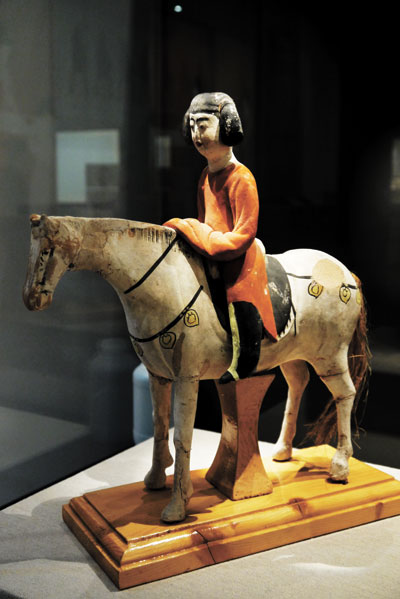
Cao Zhen
caozhen0806@126.com
AN exhibition of female tomb figurines from the Tang Dynasty (618-907) at the Shenzhen Museum is giving modern audiences a taste of what was considered beautiful and what life was like some 1,400 years ago. While a slim body is preferred today, the figurines show a completely different aesthetic, one in which plumpness was beautiful.
“It was fashionable for women to be plump in the Tang Dynasty and men enjoyed the presence of assertive, active women,” said Guo Xuelei, deputy curator of the Shenzhen Museum.
The tomb figurines were buried with the Tang emperors. They are mostly dyed pottery or glazed ceramics of lavishly dressed women with relaxed facial expressions and carefree styles. All the exhibits, including a few gold and silver jewelry pieces and daily use items, were provided by museums in Xi’an, Urumqi, Yangzhou and Zhenjiang cities.
“The Tang Dynasty was a period of unity and prosperity, when the politics and economy were highly developed. The era is regarded as a high point in Chinese civilization: a golden age with an open-minded and multicultural society,” said Guo. “As an important cultural element, women’s clothing in the era not only well illustrates the affluence, but also the openness and tolerance of society.”
Although the dyed or glazed colors from the tomb figurines have faded, viewers can still admire Tang Dynasty women’s splendid dresses complemented by elaborate hairstyles, ornaments and makeup. “The clothing materials during the Tang Dynasty were exquisite, and the dresses of the upper class were mainly made of silk. The designs were magnificent, and some clothes were even low-cut,” said Huang Yangxing, a senior researcher at the Shenzhen Museum.
The exhibition categorizes Tang women’s clothing into three general categories: the traditional ruqun or double layered or padded short jacket that was typical of ancient China; the hufu, or alien dress that came from ethnic groups or foreign countries; and menswear that broke from traditional, conservative, Confucian formalities.
Huang said the ruqun is made up of a top jacket, a long gown and a skirt, but Tang women opened up the collar to expose some cleavage, which was unprecedented in the previous dynasties and never appeared again in later dynasties. “Today, even some modern women never wear low-cut outfits, but Tang women did so freely. However, after the Song Dynasty replaced the Tang Dynasty, the Confucian classics returned and women had to cover their entire body again,” said Huang.
The hufu was not limited to outfits from ethnic groups, but also included those from Japan, Korea, Vietnam and Persia. Huang said that in the Tang Dynasty, trade and cultural exchange with foreign countries were frequent, and the Tang government respected religions, art and culture from the outside world. Chang’an, the Tang capital, therefore, became the center of exchange among different cultures. Because of this, wearing foreign clothes was a new trend within China, while the Tang style was popular abroad, in countries such as Korea, Japan, and Vietnam.
It is worth mentioning that women during the Tang Dynasty had a rebel spirit that was reflected by them wearing menswear, riding horses, hunting or playing polo, as some exhibited figurines portray. The exhibition also features extravagant ornaments and gold accessories, as well as pictures of how high-class women made up themselves and their hair.
Guo said the liberal-minded concepts of women’s social rights and social status during the Tang era were largely reserved for urban women of elite status, so there appeared some prominent women, such as China’s first and only empress, Wu Zetian, the well-known poet Xue Tao and the talented poet and politician Shangguan Wan’er. Men and women of the lower class or from the rural countryside labored hard at their domestic tasks and in farming as they always had.
Dates: Until Aug. 24
Hours: 10 a.m.-6 p.m. Closed Mondays
Venue: Shenzhen Museum, Block A, Civic Center, Futian District (福田区市民中心A区深圳博物馆新馆)
Metro: Shekou or Longhua Line, Civic Center Station (市民中心站), Exit B
|

